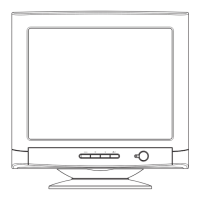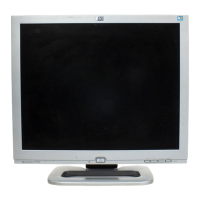
Do you have a question about the HP CRT Monitor s7500 and is the answer not in the manual?
| Display Type | CRT |
|---|---|
| Screen Size | 17 inches |
| Viewable Image Size | 16 inches |
| Horizontal Refresh Rate | 30-70 kHz |
| Vertical Refresh Rate | 50-160 Hz |
| Maximum Resolution | 1280 x 1024 |
| Recommended Resolution | 1024 x 768 |
| Dot Pitch | 0.24 mm |
| Input Connector | 1 x VGA - 15 pin D-Sub (DB-15) |
| Refresh Rate | 85 Hz |
Safety and servicing precautions to prevent damage and hazards like shock and X-rays.
Guidelines for safe servicing procedures to avoid electrical hazards, component damage, and interference.
Procedure for performing a high-voltage (Hi-Pot) test on the monitor to check insulation.
Procedure for performing a ground continuity test to ensure proper grounding.
Detailed technical specifications of the monitor, including picture tube, scanning frequency, resolution, and input.
Pin assignment details for the monitor's signal cable for data transmission.
Describes timing parameters for computer-generated video signals, including horizontal and vertical timings.
Information on the monitor's power saving modes and LED status indicators.
Details on TCO 95 and TCO 99 compliance for environmental and ergonomic standards.
Overview of the monitor's main features, including digital control, processor functions, and user modes.
Details the microcontrol section, including the NOVA NT6865 CPU, its memory, peripherals, and functions.
Explains the deflection section, focusing on the autosync deflection controller TDA4841.
Describes the horizontal section, including oscillator, sync, and driver circuits.
Describes the vertical section, including sync input and free-running frequency.
Details the vertical output section, including differential outputs and power supply.
Explains East-West, Trapezoid, and Horizontal Width controls and their circuitry.
Details the X-ray protection mechanism and its activation conditions.
Describes the G1, blanking, and brightness control signals and their functions.
Explains how contrast is controlled and beam current detection for ABL function.
Explains H/V size breathing compensation mechanisms based on beam current and HV voltage.
Describes the dynamic focus circuitry for improving corner focus performance.
Details the monitor's power supply system, including AC rectification, line filtering, and power LED status.
Explains the synchronization methods for normal, power saving, and override modes.
Describes the Over-Voltage Protection (OVP) feature that activates when auxiliary voltage is high.
Explains the Over-Power Protection (OPP) feature that limits power when excess current is detected.
Details the step-up power supply for the Flyback Transformer (FBT) and its regulation.
Describes the video amplifier stages, pre-amp, output stage, and OSD function.
Outlines general adjustment conditions, necessary equipment, and power supply regulator settings.
Provides step-by-step procedures for various monitor alignments, including HV and color settings.
Covers both automatic degaussing activation and manual degaussing steps.
Troubleshooting flowchart for diagnosing and resolving issues when the monitor displays no raster.
Troubleshooting flowchart for issues related to the On-Screen Display (OSD) not functioning correctly.
Troubleshooting flowchart for diagnosing and fixing problems with the monitor's function keys.
Troubleshooting flowchart for diagnosing issues where the monitor shows no vertical scan.
Troubleshooting flowchart for resolving issues with horizontal synchronization.
Troubleshooting flowchart for resolving issues with vertical synchronization.
Troubleshooting flowchart for issues with the RGB video amplifier.
Procedure for troubleshooting blank EEPROM issues and data auto-reload.











